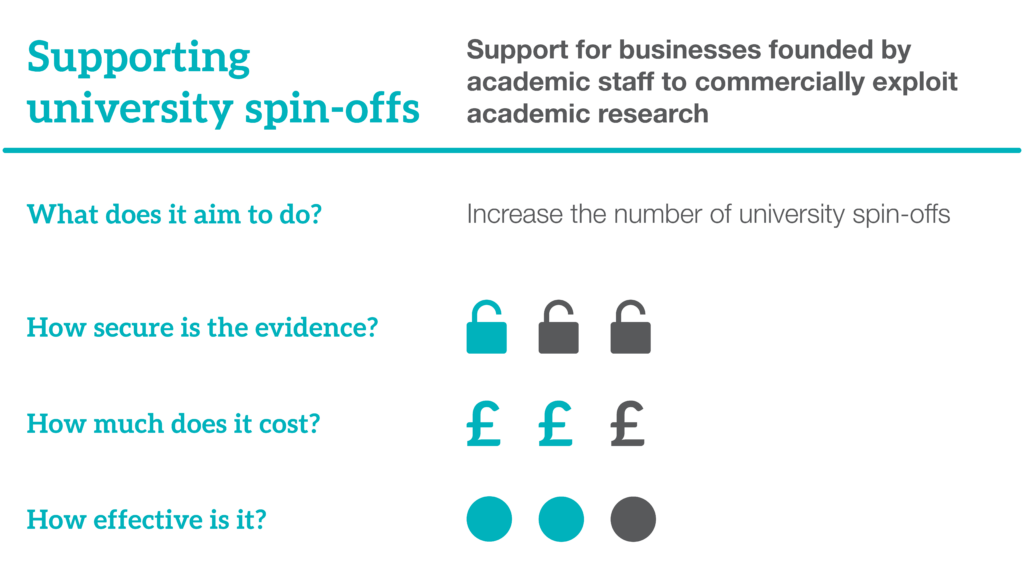
What are they and what do they aim to do?
University spin-offs are business ventures founded by academic staff to commercially exploit academic research.
Spin-offs can strengthen the linkage between universities, industry and the local economy (the “Triple Helix”) and are one way in which university research may have a significant impact on local economic development. Proponents of supporting university spin-offs argue that they are flexible and dynamic, playing an important role in the introduction of new-to-the-market products and the development of high-tech clusters. Others urge caution, because of the standard concerns around non-market interventions in innovative activities (e.g. universities supporting academics to create spin-offs may crowd out private sector entrepreneurship) and because of unintended consequences on universities themselves (e.g. encouraging spin-off activity may remove resources from basic research).
This toolkit does not address these bigger picture questions. Instead, it summarises the available empirical evidence on two key decisions that can affect the number and performance of university spin-offs:
- the rules which govern whether the university or researcher owns (more of) the intellectual property rights and the broader set of incentives provided to academics
- the ways in which universities support technology transfer, including through dedicated offices (TTOs). The set of studies that consider these issues also consider the way in which different university or area characteristics affect spin-offs.
Although not our focus, we also summarise those findings.
Things to consider
- Can changing the rules governing intellectual property increase the number of spin-offs? The evidence on who should own Intellectual Property Rights (IPR) and what good rules look like is inconclusive, so any changes to intellectual property rights will need careful monitoring and evaluation to establish the effect on spin-offs and other activity.
- Is university-provided entrepreneurial support effective in promoting academic spin-offs? Again, the evidence is mixed. Universities investing in TTOs will need to monitor and evaluate performance – both in terms of introduction of the support but also when considering changes to support (e.g. increasing TTO size). The same holds for other schemes (e.g. to provide equity or limit entrepreneurial risk).
- What’s the role of university-industry collaboration and different funding sources? Collaboration may have a positive effect on spin-offs, but the evidence is less clear on the appropriate funding mix. There is some evidence that private sector funding may reduce spin-offs – possibly because collaborating firms use any resulting innovations directly. This raises an interesting question about whether spin-offs (as opposed to other forms of university-industry collaboration) are the best way to facilitate knowledge transfers to the local economy.
- Should policy that supports spin-offs target particular types of universities? Again, the evidence is inconclusive which highlights the importance of monitoring and evaluating the impact of different support schemes.
How effective are they?
There are more studies addressing elements of spin-off policy design than we typically find for our toolkits – 17 studies met our toolkit requirements, two from the UK. However, the variety of design elements and objectives covered by these studies, combined with the inconclusive nature of many of the findings, means that we can offer little guidance as to what works best in this area.
The evidence is inconclusive on whether university or researcher ownership of IPR is better for spin-offs. Two studies find that allocating IPR to researchers increases the number of spin-offs [1,2]. Two studies [3,4] find the opposite (i.e. a positive effect of allocating IPR to universities).
The evidence is mixed on whether TTOs increase spin-offs: three studies [6, 7, 8] find positive effects on the number of spin-offs while two find no effect [3, 5]. One study [9] finds positive effects for the number of spin-offs but negative effects on the ‘quality’ (the proportion of spin-offs that receive first round VC funding).
The evidence is also mixed on whether TTO size, experience or specialisation increase spin-offs: five studies find that size has a positive, although less than proportionate, effect on the number of spin-offs [1, 6, 8, 10, 11], three find no effect [12, 13, 14]. Two find positive effects for experience [7, 9], two find no effect [10, 14]. One study finds positive effects for specialisation [11], another finds no effect [10].
The evidence is mixed on other things universities do to directly support spin-offs: two studies suggest clearer university rules on spin-offs might help with the number of spin-offs [2, 10] but one of these cautions that this is only if rules are not too strict [2]. One study finds positive effects of university equity policies, but not access to venture capital [4]. Another suggests that reducing entrepreneurial risk has no effect [2].
University-industry (U-I) partnerships may have a positive effect on spin-offs: the two studies that consider university-industry collaboration both find evidence of positive effects on the number of spin-offs [14, 15]. A third study [16] shows that geographical proximity of new start-ups to the parent university (which may facilitate collaboration) increases the number of innovative products and patents.
Public funding may have a positive impact on spin-offs and vice-versa for private funding. Two studies [7, 17] find a positive effect of public sector finding on the number of spin-offs. In contrast, one study finds a negative effect of private sector funding [17], while two more find no effect [4, 7].
The evidence is mixed on whether university patenting activity and eminence increases spin-offs. Two studies find positive effects of patent activity [6, 11] on the number of spin-offs, one no effect [7] and one negative effect [13]. Three studies [4, 5, 9] find that more eminent universities (measured by the number of graduate staff and quality of research) increase the number of spin-offs. However, two studies [7, 14] find no effect.
The size of a university may increase spin-offs. Two studies [10, 17], find that the size of the university measured by the number of faculty members seems to increase spin-offs (although only one of these is clear that the effect is more than proportionate).
Are spin-offs cost effective?
There is very limited evidence on the overall economic benefits of spin-offs on local economies. None of the studies provides a discussion of the cost-effectiveness of specific interventions which might increase the number or quality of spin-offs.





